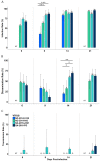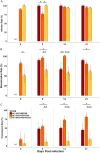Differential transmission of Asian and African Zika virus lineages by Aedes aegypti from New Caledonia
- PMID: 30254274
- PMCID: PMC6156223
- DOI: 10.1038/s41426-018-0166-2
Differential transmission of Asian and African Zika virus lineages by Aedes aegypti from New Caledonia
Abstract
Zika virus (ZIKV) is a Flavivirus that is transmitted to humans by Aedes mosquitoes. ZIKV is divided into two phylogenetic lineages, African and Asian. In the Asian lineage, Pacific and American clades have been linked to the recent worldwide outbreak of ZIKV. The aim of this study was to measure the vector competence of Aedes aegypti for seven ZIKV strains belonging to both lineages. We demonstrate that Ae. aegypti from New Caledonia (NC), South Pacific region, is a low-competence vector for Asian ZIKV (<10% transmission efficiency). No significant differences were observed in vector competence with respect to the sampling date and collection site of Asian ZIKV strains used (2014 and 2015 for New Caledonia, Pacific clade, and 2016 for French Guiana, American clade). The ability of the New Caledonian Ae. aegypti to transmit ZIKV is significantly greater for the earlier viral isolates belonging to the African lineage (>37% transmission efficiency after 9 days post-infection) compared to recent ZIKV isolates from African (10% transmission efficiency) and Asian lineages (<10% transmission efficiency). The results of this study demonstrate that Ae. aegypti from NC can become infected and replicate different ZIKV strains belonging to all lineages. Our data emphasize the importance of studying the interaction between vectors and their arboviruses according to each local geographic context. This approach will improve our understanding of arbovirus transmission to prevent their emergence and improve health surveillance.
Conflict of interest statement
The authors declare that they have no conflict of interest.
Figures



Similar articles
-
Transmission potential of African, Asian and American Zika virus strains by Aedes aegypti and Culex quinquefasciatus from Guadeloupe (French West Indies).Emerg Microbes Infect. 2019;8(1):699-706. doi: 10.1080/22221751.2019.1615849. Emerg Microbes Infect. 2019. PMID: 31109248 Free PMC article.
-
Zika virus outbreak in the Pacific: Vector competence of regional vectors.PLoS Negl Trop Dis. 2018 Jul 17;12(7):e0006637. doi: 10.1371/journal.pntd.0006637. eCollection 2018 Jul. PLoS Negl Trop Dis. 2018. PMID: 30016372 Free PMC article.
-
Evidence for infection but not transmission of Zika virus by Aedes albopictus (Diptera: Culicidae) from Spain.Parasit Vectors. 2019 May 3;12(1):204. doi: 10.1186/s13071-019-3467-y. Parasit Vectors. 2019. PMID: 31053164 Free PMC article.
-
Zika Virus Mosquito Vectors: Competence, Biology, and Vector Control.J Infect Dis. 2017 Dec 16;216(suppl_10):S976-S990. doi: 10.1093/infdis/jix405. J Infect Dis. 2017. PMID: 29267910 Free PMC article. Review.
-
An overview of mosquito vectors of Zika virus.Microbes Infect. 2018 Dec;20(11-12):646-660. doi: 10.1016/j.micinf.2018.01.006. Epub 2018 Mar 2. Microbes Infect. 2018. PMID: 29481868 Review.
Cited by
-
Transmission potential of African, Asian and American Zika virus strains by Aedes aegypti and Culex quinquefasciatus from Guadeloupe (French West Indies).Emerg Microbes Infect. 2019;8(1):699-706. doi: 10.1080/22221751.2019.1615849. Emerg Microbes Infect. 2019. PMID: 31109248 Free PMC article.
-
Vector Competence of Aedes aegypti, Aedes albopictus and Culex quinquefasciatus from Brazil and New Caledonia for Three Zika Virus Lineages.Pathogens. 2020 Jul 16;9(7):575. doi: 10.3390/pathogens9070575. Pathogens. 2020. PMID: 32708536 Free PMC article.
-
European Aedes caspius mosquitoes are experimentally unable to transmit Zika virus.Parasit Vectors. 2019 Jul 25;12(1):363. doi: 10.1186/s13071-019-3620-7. Parasit Vectors. 2019. PMID: 31345269 Free PMC article.
-
Immune Recognition versus Immune Evasion Systems in Zika Virus Infection.Biomedicines. 2023 Feb 20;11(2):642. doi: 10.3390/biomedicines11020642. Biomedicines. 2023. PMID: 36831177 Free PMC article. Review.
-
Warming temperatures could expose more than 1.3 billion new people to Zika virus risk by 2050.Glob Chang Biol. 2021 Jan;27(1):84-93. doi: 10.1111/gcb.15384. Epub 2020 Oct 28. Glob Chang Biol. 2021. PMID: 33037740 Free PMC article.
References
MeSH terms
LinkOut - more resources
Full Text Sources
Other Literature Sources
Medical
